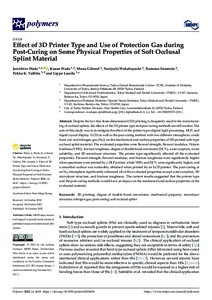Effect of 3D Printer Type and Use of Protection Gas during Post-Curing on Some Physical Properties of Soft Occlusal Splint Material
Wada Kanae; Vallittu Pekka K; Lassila Lippo; Gibreel Mona; Wakabayashi Noriyuki; Iwamoto Tsutomu; Wada Junichiro
Effect of 3D Printer Type and Use of Protection Gas during Post-Curing on Some Physical Properties of Soft Occlusal Splint Material
Wada Kanae
Vallittu Pekka K
Lassila Lippo
Gibreel Mona
Wakabayashi Noriyuki
Iwamoto Tsutomu
Wada Junichiro
MDPI
Julkaisun pysyvä osoite on:
https://urn.fi/URN:NBN:fi-fe2022121671971
https://urn.fi/URN:NBN:fi-fe2022121671971
Tiivistelmä
Despite the fact that three-dimensional (3D) printing is frequently used in the manufacturing of occlusal splints, the effects of the 3D printer type and post-curing methods are still unclear. The aim of this study was to investigate the effect of the printer type (digital light processing: DLP; and liquid crystal display: LCD) as well as the post-curing method with two different atmospheric conditions (air and nitrogen gas (N-2)) on the mechanical and surface properties of 3D-printed soft-type occlusal splint material. The evaluated properties were flexural strength, flexural modulus, Vickers hardness (VHN), fracture toughness, degree of double bond conversion (DC%), water sorption, water solubility, and 3D microlayer structure. The printer type significantly affected all the evaluated properties. Flexural strength, flexural modulus, and fracture toughness were significantly higher when specimens were printed by a DLP printer, while VHN and DC% were significantly higher, and a smoother surface was noticeably obtained when printed by an LCD printer. The post-curing at an N-2 atmosphere significantly enhanced all of the evaluated properties except water sorption, 3D microlayer structure, and fracture toughness. The current results suggested that the printer type and the post-curing methods would have an impact on the mechanical and surface properties of the evaluated material.
Kokoelmat
- Rinnakkaistallenteet [19250]
